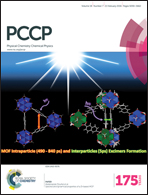Carrier separation and charge transport characteristics of reduced graphene oxide supported visible-light active photocatalysts†
Abstract
Extending the absorption to the visible region by tuning the optical band-gap of semiconductors and preventing charge carrier recombination are important parameters to achieve a higher efficiency in the field of photocatalysis. The inclusion of reduced graphene oxide (rGO) support in photocatalysts is one of the key strategies to address the above-mentioned issues. In this study, rGO supported AgI–mesoTiO2 photocatalysts were synthesized using a sonochemical approach. The physical effects of ultrasound not only improved the crystallinity of AgI–mesoTiO2 but also increased the surface area and loading of the AgI–mesoTiO2 nanocomposite on rGO sheets. The low intense oxygen functionalities (C–O–C and COOH groups) peak observed in the high resolution C1s spectrum of a hybrid AgI–mesoTiO2–rGO photocatalyst clearly confirmed the successful reduction of graphene oxide (GO) to rGO. The interfacial charge transfer between the rGO and the p–n junction of heterostructured photocatalysts has decreased the band-gap of the photocatalyst from 2.80 to 2.65 eV. Importantly, the integration of rGO into AgI–mesoTiO2 composites serves as a carrier separation centre and provides further insight into the electron transfer pathways of heterostructured nanocomposites. The individual effects of photo-generated electrons and holes over rGO on the photocatalytic degradation efficiency of rhodamine (RhB) and methyl orange (MO) using AgI–mesoTiO2–rGO photocatalysts were also studied. Our experimental results revealed that photo-generated superoxide (O2−˙) radicals are the main reactive species for the degradation of MO, whereas photo-generated holes (h+) are responsible for the degradation of RhB. As a result, 60% enhancement in MO degradation was observed in the presence of rGO in comparison to that of the pure AgI–mesoTiO2 photocatalyst. This is due to the good electron acceptor and the ultrafast electron transfer properties of rGO that can effectively reduce the molecular oxygen to produce a large amount of reactive O2−˙ radicals. However, in the case of RhB degradation, h+ is the main reactive species which showed a slightly increased photocatalytic activity (12%) in the presence of rGO support where the role of rGO is almost negligible. This study suggests the effective roles of rGO for the degradation of organics, i.e., the rate of photocatalytic degradation also depends on the nature of compound rather than rGO support.


 Please wait while we load your content...
Please wait while we load your content...